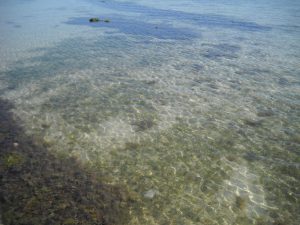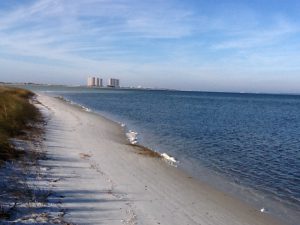For many, it really does not matter. But is there a difference? Yes… there is. Seagrass is what typically washes ashore on the Sound side – seaweed is what we typically see on the Gulf.

Photo: Leroy Creswell
So what is the difference?
Seagrasses are actually grasses. They are true plants in the sense they have roots, stems, and leaves. They also produce flowers, but they are so small it is very hard to see them. Pollen and seed dispersal is via the currents. What the observer sees when snorkeling in seagrass meadows are the leaves – in this case called blades. The stems run horizontal beneath the sand, as many grasses in our lawns do. These are called rhizomes, and the roots extend from them. Turtle grass and Shoal grass are the two most common types we have here.
Seaweeds on the other hand, are not true plants because they lack roots, stems, and leaves. They are often called algae and must be submerged in water in order to absorb it. They are either float and drift in the currents, or can attach to hard objects on the seafloor using a structure called a holdfast. June grass and Sargassum are two common types that drift ashore.
So why don’t seagrasses grow in the Gulf?
Like all plants, seagrasses need sunlight. At least 25% of the sunlight reaching the surface must reach the bottom for them to photosynthesize. Near the shore, there is enough sunlight for seagrass, but they cannot tolerate the larger waves that our nearshore Gulf produces – thus they are restricted to the quieter waters of the Sound. We do have seagrasses growing in Big Lagoon, Old River, parts of Pensacola Bay, and even in some of the local bayous. This ecosystem is important to the overall health of our bay. It is known that 80-90% of the commercially and recreationally important finfish and shellfish require seagrasses, or salt marshes, for at least part of their life cycle – so they are important economically as well.
Seaweeds also need sunlight. In rocky areas, you can find them attached in sunlit waters. Much of our area is sand, so we do not see as many forms of seaweed as they do in the Keys or in California. However, we do have floating forms.

Photo: Rick O’Connor
March is “Seagrass Awareness Month”. Many people provide opportunities to educate locals about our seagrasses and the issues they are facing. Excessive run-off from parking lots, ramps, homes, etc. – increase the turbidity and decrease the salinity of the water – both of which are detrimental to seagrass health. This run-off also contains pollutants that are problematic – particularly nutrients from fertilizers. The fertilizers trigger algal blooms which block sunlight and, in some cases, smoother the surface of the grass blades. Then there is prop scarring. The shallow waters where they live are also popular spots for boaters to visit. The propeller scarring leaves open tracts throughout the seagrass meadows and, unlike some grasses in our yards, can take years – even decades – to recover. There has been significant loss of seagrass all across the Gulf region, including Pensacola Bay. The loss of seagrass have also affected species such as bay scallop and horseshoe crabs. There are signs of recovery and we need to continue reducing our impact to keep this trend going. Florida Friendly Landscaping, Clean Boater practices, and Living Shorelines are some methods that can help. Contact your local County Extension Office to learn more about these programs.
 0
0
